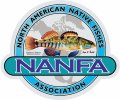Captive Care Notes: Redside Shiners (Richardsonius, Family Cyprinidae)
Despite being small, colorful, common, and commonly used as bait, no literature seems to exist on the aquarium care of Redside Shiner (Richardsonius balteatus) and Lahontan Redside (R. egregius). This may be attributable in part to the restrictive collecting and possession laws that exist in most western states except Oregon. In Nevada, R. egregius is an approved bait fish and may be possessed in authorized waters.
Oregon NANFA member Norm Edelen has kept both species in the genus and reports that they do not require special care. "Treat them like giant danios and they do fine," Norm says (pers. comm.). "They are fragile when small or first captured, and they stress easily during shipping, but once in a tank they do great." John Fisher, an aquarist at the Vancouver Aquarium, concurs that wild-caught R. balteatus are initially sensitive but quite hardy once established in captivity (pers. comm.). The key to their long-term survival is gentle handling in the field and clean, well-aerated water during transport. Display specimens are kept in 60 l (16 gal) tanks but school nicely in larger displays. They are peaceful and can be kept in community tanks. Display water ranges from 5-16C (41-59F) with an average pH of 6.7. They eat most prepared and frozen foods.
Unfortunately, captive Richardsonius do not seem to show an interest in spawning, nor do they display the vivid red color that's earned them their common names. The book American Aquarium Fishes suggests breeding requirements may be similar to those of Crescent Shiner (Luxilus cerasinus) but offers no reasons why. Perhaps the key to coaxing Richardsonius to spawn is a dark cooling down period that simulates their wintering in deeper waters followed by a gradual increase in temperature and light.
Wild-collected R. balteatus eggs have been hatched and raised in the laboratory. Hatching took 3-7 days at 21-23C (70-73F). Newly hatched fry remained hidden in the rocks for eight days and begin taking food at 10.
